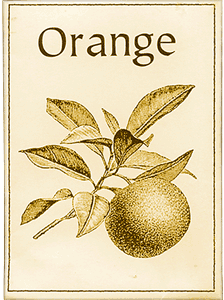ORANGE
Vitals
• Citrus sinensis , belonging to the citrus family, Rutaceae .
• Origin: China.
• Earliest literary reference: Oranges are mentioned in the second book of the Chinese “Five Classics” written in 500 BC.
• Other early literary references: Writers of ancient Greece recorded farmers growing citrus, but not oranges. How lemons, pummelos, and others gave rise to oranges is not known.
• Climate: Subtropical and mostly dry, though ideal conditions vary greatly among varieties.
• Major producing countries: Brazil, United States, Mexico.
The storyNext time you spit out an orange seed, ponder this: Plant it, and you might get some funny looking fruits—lime-oranges, perhaps, or orange-grapefruits. The lines between citrus species have been blurred by years of promiscuity between citrus trees. Most plants confine their sexual encounters to members of their own species. No such boundaries for citrus: An orange blossom welcomes pollen from a nearby lemon as readily as it takes pollen from itself. Citrus is so prolific, it even has a way to produce seeds without having to depend on pollination. The result is a bit of reproductive chaos.
So what's an orange grower to do? Two thousand years ago, the Chinese answered this question by cutting off the branch of one citrus tree and coercing it to grow onto the stump of a different citrus tree. In this process, called grafting , the branch grows with the tree and produces the same fruit season after season. Need more orange trees? Rather than taking the risk of growing them from seed, farmers can simply cut more orange branches and put them on more stumps. Grafting is how most citrus fruits (and some other fruits, including apples) are grown today.
DNA analysis suggests that all citrus fruits can be traced back to three wild ancestors: the citron, the pummelo, and the mandarin. Oranges, like most other citrus fruits, don't exist in the wild. Not much is known about how they came to be, but they are certainly the result of human manipulation. They are thought to have originated in the Far East. From there, they spread to the Middle East, and Arabs are reported to have been growing oranges in Spain in the tenth century. For the next 500 years, oranges were grown by royalty in Europe and were considered exotic. The orange arrived in the Americas aboard Spanish ships in the 1500s, and Spaniards planted the trees in missions in California and Arizona. In time, groves of the tasty fruit became a familiar sight on every continent but Antarctica. Today, oranges are the most widely grown fruit trees in the world, and they are also used ornamentally during some Chinese holidays.
The “orangeness” of an orange is related to temperature and environment, not ripeness. In some parts of the world, oranges are actually green. The orange color comes from exposure to cold. For growers, this means striking a delicate balance in places where the evening winter temperatures dip. In central California, for example, a brisk December evening can bring bright orange color to the fruit, but prolonged exposure to the cold will ruin the crop. These days, some oranges grown in warmer climes are picked green and treated with ethylene gas (which is nontoxic, and is given off by many fruits) to bring out the color. Others, like valencias, occasionally go from green to orange and back to green again as they get sweeter.
If you have an orange tree in your garden (we wouldn't, of course, encourage you to ogle the orange tree in your neighbor’s garden), do some periodic tastings to find out when the fruit is ripe to your liking. When you pick your oranges, remember these rules: The south side of the tree produces the sweetest fruits. Those on top are likely to be better than those toward the bottom. The ones outside will be sweeter than the ones toward the inside of the tree. On top of that, the flesh at the blossom (bottom) end of the orange is sweeter and juicier than the stem end. Try comparing them next time you eat an orange—after pondering those enigmatic seeds, of course.
Saving the seedSaving orange seeds is easy and tricky at the same time. Getting the seed itself is simple:
• Visit your local grocery store and find an orange with seeds in it (e.g. a valencia, not a navel)
• Enjoy your orange and set aside the seeds.
• Let the seeds dry to the touch. Don’t let them dry out completely. They can be planted soon after you’ve finished your snack.
The tricky part is deciding whether you want to grow an orange tree from seed. It’s a project that calls for patience. You can easily grow a nice tree with shiny leaves to admire, but it would not be unusual for ten or fifteen years to pass before you see any fruit. And depending on how the seed you planted was formed, the fruit will either be identical to the orange you ate (if you can remember that far back), or it may be a different sort of orange, or the result of a citrus hybrid. To avoid these confusions, it’s best to plant a grafted tree in your yard. Some citrus trees will also grow indoors. You can sometimes find trees with fruit on them in your local garden store. Look closely at the trunk, and you are likely to see a thin line around it. This is where the orange has been grafted onto the stump, or rootstock, of another tree. To learn more about grafting, read our Three Ways to Make A New Plant article.
Read our article Why Save Seeds? to learn more about that.
